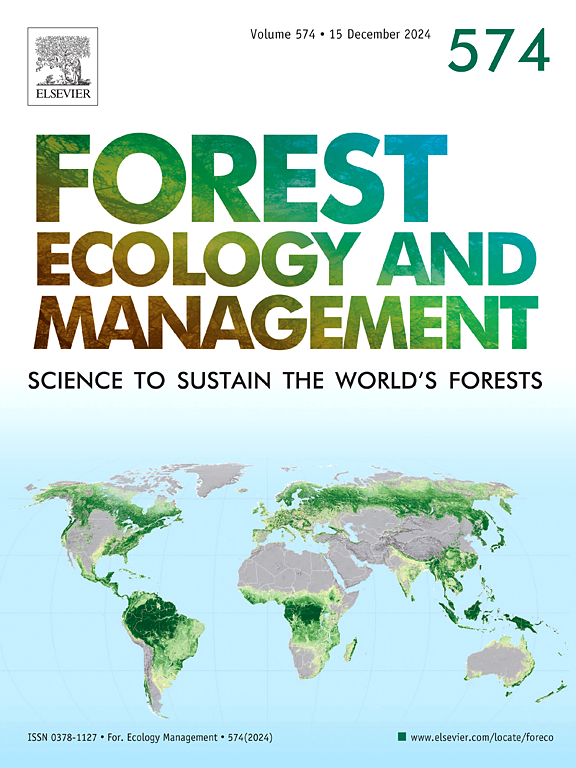Afforestation increases glomalin-related soil protein content and enhances its association with stable soil carbon in karst regions
IF 3.7
2区 农林科学
Q1 FORESTRY
引用次数: 0
Abstract
Afforestation is widely regarded as a practical approach to enhance soil organic carbon (SOC) storage. Glomalin-related soil protein (GRSP), primarily produced by arbuscular mycorrhizal fungi, is vital for promoting SOC storage. However, the effects of afforestation on GRSP accumulation in bulk soil and the mineral-associated organic matter (MAOM) fraction, along with its relationship with mineral-associated organic carbon (MAOC), remains poorly understood, particularly in karst soils characterized by high mineral content. This study investigated these dynamics across six sites in the karst region of southwestern China, representing a broad climatic gradient. We collected 30 soil samples (0–10 cm) each from croplands and plantations along the gradient, analyzing SOC and GRSP content in both bulk soils and MAOM fractions. We found that afforestation significantly increased SOC by 58.1 % in bulk soils and 57.8 % in MAOM fractions, while MAOC rose by 63.2 %. The total GRSP content increased by 9.5 % in bulk soils and 10.8 % in MAOM fractions, compared to croplands, associated with higher soil nitrogen content and microbial biomass carbon after afforestation. However, the contribution of GRSP to SOC decreased after afforestation, likely due to increased plant-derived carbon inputs. Notably, GRSP contributed more to soil carbon in the MAOM fractions than in bulk soils across both croplands and plantations. Additionally, GRSP content showed a positively correlation with MAOC and SOC, suggesting a strong association with soil carbon stability. Furthermore, higher mean annual precipitation promoted GRSP accumulation, primary by increasing soil nutrient content. These findings highlight that while afforestation reduces the contribution of GRSP to SOC in karst regions, it enhances overall GRSP content, thereby increasing SOC stability. Furthermore, areas with higher precipitation offer greater potential for SOC stabilization through afforestation, though increased dissolved organic carbon leaching may temper this effect, providing valuable insights for carbon sequestration strategies in karst ecosystems.
造林增加了喀斯特地区土壤球蛋白相关蛋白含量,增强了其与土壤稳定碳的关联
植树造林是提高土壤有机碳储量的有效途径。Glomalin-related soil protein (GRSP)主要由丛枝菌根真菌产生,对促进有机碳的储存至关重要。然而,造林对大块土壤和矿物伴生有机质(MAOM)组分中GRSP积累的影响及其与矿物伴生有机碳(MAOC)的关系尚不清楚,特别是在矿物含量高的喀斯特土壤中。本研究在中国西南喀斯特地区的6个地点调查了这些动态,代表了一个广泛的气候梯度。在坡地和人工林各采集了30个土壤样品(0-10 cm),分析了大块土壤和MAOM组分中有机碳和GRSP的含量。结果表明,造林可显著提高土壤有机碳(SOC)含量(58.1% %)和土壤有机质(MAOM)含量(57.8% %),土壤有机质(MAOC)含量(63.2% %)。与农田相比,粗粒土壤总GRSP含量增加了9.5 %,MAOM组分增加了10.8 %,这与造林后土壤氮含量和微生物生物量碳含量增加有关。然而,造林后GRSP对有机碳的贡献减少,可能是由于植物源碳输入增加。值得注意的是,在农田和人工林中,GRSP对MAOM组分土壤碳的贡献大于散装土壤。GRSP含量与MAOC、SOC呈显著正相关,表明其与土壤碳稳定性密切相关。此外,较高的年平均降水量促进了GRSP的积累,主要是通过增加土壤养分含量。这些结果表明,造林虽然降低了喀斯特地区土壤有机碳中GRSP的贡献,但提高了土壤有机碳的总体含量,从而提高了土壤有机碳的稳定性。此外,降水较多的地区通过植树造林提供了更大的稳定有机碳的潜力,尽管增加的溶解有机碳淋滤可能会缓和这种效应,为喀斯特生态系统的碳封存策略提供了有价值的见解。
本文章由计算机程序翻译,如有差异,请以英文原文为准。
求助全文
约1分钟内获得全文
求助全文
来源期刊

Forest Ecology and Management
农林科学-林学
CiteScore
7.50
自引率
10.80%
发文量
665
审稿时长
39 days
期刊介绍:
Forest Ecology and Management publishes scientific articles linking forest ecology with forest management, focusing on the application of biological, ecological and social knowledge to the management and conservation of plantations and natural forests. The scope of the journal includes all forest ecosystems of the world.
A peer-review process ensures the quality and international interest of the manuscripts accepted for publication. The journal encourages communication between scientists in disparate fields who share a common interest in ecology and forest management, bridging the gap between research workers and forest managers.
We encourage submission of papers that will have the strongest interest and value to the Journal''s international readership. Some key features of papers with strong interest include:
1. Clear connections between the ecology and management of forests;
2. Novel ideas or approaches to important challenges in forest ecology and management;
3. Studies that address a population of interest beyond the scale of single research sites, Three key points in the design of forest experiments, Forest Ecology and Management 255 (2008) 2022-2023);
4. Review Articles on timely, important topics. Authors are welcome to contact one of the editors to discuss the suitability of a potential review manuscript.
The Journal encourages proposals for special issues examining important areas of forest ecology and management. Potential guest editors should contact any of the Editors to begin discussions about topics, potential papers, and other details.
 求助内容:
求助内容: 应助结果提醒方式:
应助结果提醒方式:


